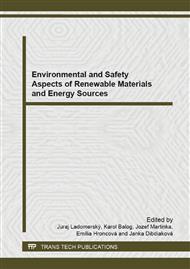[1]
Directive 2004/54/EC on minimum safety requirements for tunnels in the Trans-European Road Network. European Parliament and Council, (2004).
Google Scholar
[2]
Infason, H.; Wickström U. The international FORUM of fire research directors: A position paper on future actions for improving road tunnel fire safety. Fire Safety Journal 41(2), (2006) p.111–114.
DOI: 10.1016/j.firesaf.2005.11.006
Google Scholar
[3]
Ko, J.; Yoon, Ch.; Yoon, S.; Kim, J. Determination of the applicable exhaust airflow rate through a ventilation shaft in the case of road tunnel fires. Safety Science 48 (6), (2010), p.722–728.
DOI: 10.1016/j.ssci.2010.02.007
Google Scholar
[4]
Carvel, R.; Beard, A. The Handbook of Tunnel Fire Safety. Thomas Telford, (2005), 514 p.
Google Scholar
[5]
Čajka, R., Matečková, P. Fire Resistance of Ceiling Slab Concreted in Trapezoidal Sheet. Procedia Engineering 65, 2013, p.393–396. doi: 10. 1016/j. proeng. 2013. 09. 061.
DOI: 10.1016/j.proeng.2013.09.061
Google Scholar
[6]
ISO 834-1: 1999 Fire-resistance tests - Elements of building construction - Part 1: General requirements. Switzerland: International Organization for Standardization, 1999. 25 p.
Google Scholar
[7]
Kučera, P.; Pokorný, J. Determination of Temperature Conditions for a Design of Engineering Construction during a Fire. Communications – Scientific Letter of the University Žilina 13(2), (2011), p.83–87.
Google Scholar
[8]
ČSN EN 13501-2+A1: 2010 Požární klasifikace stavebních výrobků a konstrukcí staveb - Část 2: Klasifikace podle výsledků zkoušek požární odolnosti kromě vzduchotechnických zařízení. Czech Republic: Czech Office for Standards, Metrology and Testing, (2010).
Google Scholar
[9]
Bradáčová, I.; Kučera, P. Concrete Structures Restoration from the Fire Safety Point of View. Advanced Materials Research. 688(113), 2013, p.113–119. doi: 10. 4028/www. scientific. net/AMR. 688. 113.
DOI: 10.4028/www.scientific.net/amr.688.113
Google Scholar
[10]
Floyd, J.; McDermott, R.; Hostikka, S.; McGrattan, K. Fire Dynamics Simulator (Version 5): User´s Guide. NIST Special Publication 1019-5. Washington, (2010). 222 p.
DOI: 10.6028/nist.sp.1019-5
Google Scholar
[11]
Kučera, P.; Pezdová, Z. Základy matematického modelování požáru. Association of Fire and Safety Engineering, (2010), 111 p. (in Czech).
Google Scholar
[12]
Cheong M K; Spearpoint M J; Fleischmann C. M. Design fires for vehicles in road tunnels, in Proceeding 7th International Conference on Performance-Based Codes and Fire Safety Design Methods, Auckland, New Zealand, (2008), pp.229-240.
Google Scholar
[12]
Migoya, E.; García, J.; Crespo, A.; Gago, C.; Rubio, A. 2011. Determination of the heat release rate inside operational road tunnels by comparison with CFD calculations. Tunnelling and Underground Space Technology 26 (1), 2011, p.211–222.
DOI: 10.1016/j.tust.2010.05.001
Google Scholar
[13]
Fire in Tunnels: FIT General Report, Thematic Network Fire in Tunnels, Brussels, Belgium, (2006).
Google Scholar
[14]
Martinka, J.; Kačíková, D.; Hroncová, E.; Ladomerský, J. 2012. Experimental determination of the effect of temperature and oxygen concentration on the production of birch wood main fire emissions. Journal of Thermal Analysis and Calorimetry 110 (1), 2012, p.193.
DOI: 10.1007/s10973-012-2261-2
Google Scholar
[15]
Martinka, J.; Balog, K.; Chrebet, T.; Hroncová, E.; Dibdiaková, J. 2012. Effect of oxygen concentration and temperature on ignition time of polypropylene. Journal of Thermal Analysis and Calorimetry 110 (1), 2012, p.485–487.
DOI: 10.1007/s10973-012-2546-5
Google Scholar


